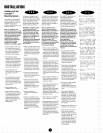
HORIZONTAL VERTICAL
Boundary Loading
-
This is a good trick for increasing bass
without taxing the amplifier. It is also possible to make a system
sound too "muddy", so use caution. If you move the speaker from
open space to a wall, bass notes will increase by
+
3dB. If you
move it to a
2
boundary corner, another t3dB
...
and another t3dB
for a three boundary corner! (see diag.
4).
frequencies go where you point them.
Simply aim the center axis of the
speaker into the plane slightly above
the listening area. The 90" x 90"
horns of the Control@ Contractor
Series disperse the high notes by
45"
off axis in every direction. For large or
unusually shaped rooms, divide the
area into zones and let the horn
patterns dictate the spacing between
the speakers (see diag.
5)-
AMPLIFIER
-
f
TYPICAL DAISY CHAIN CONFIGURATION
TYPICAL "HOME RUN" CONFIGURATION
Daisy Chaining
-
It is most common, easiest, and cheapest
to run wires from the amp to a speaker, then from that
speaker to another (see diag. 6A).
Home
Runs
-
If you desire true stereo
L
&
R
from each
listening position, "home runs" are best, from the amplifier
directly to each speaker (see diag. 6B).
















